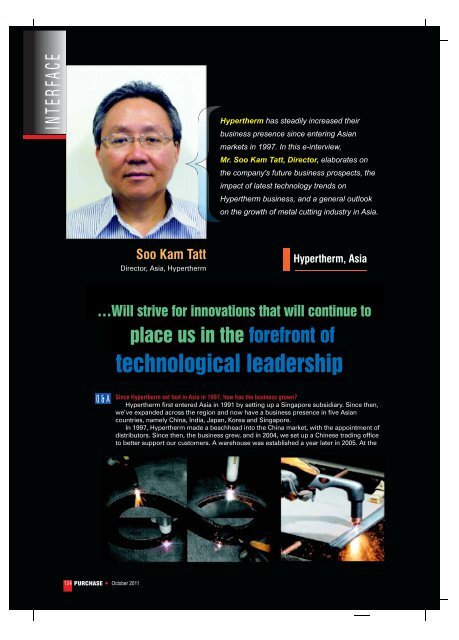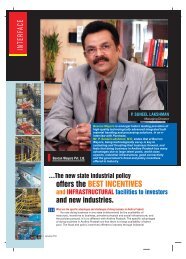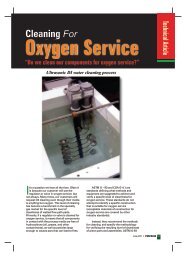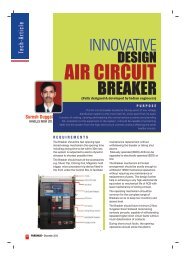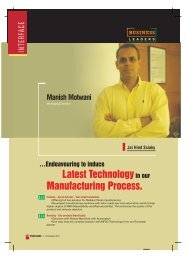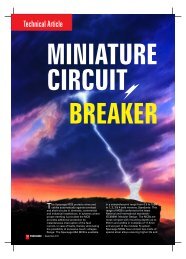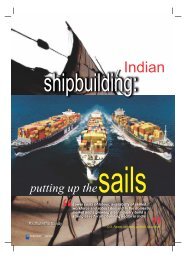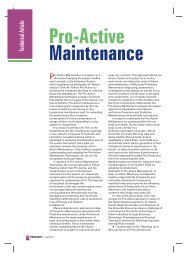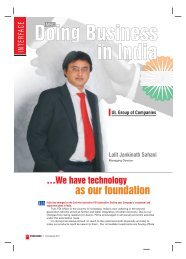Hypertherm, Asia - Industrial Products
Hypertherm, Asia - Industrial Products
Hypertherm, Asia - Industrial Products
You also want an ePaper? Increase the reach of your titles
YUMPU automatically turns print PDFs into web optimized ePapers that Google loves.
I N T E R F A C E<br />
<strong>Hypertherm</strong> has steadily increased their<br />
business presence since entering <strong>Asia</strong>n<br />
markets in 1997. In this e-interview,<br />
Mr. Soo Kam Tatt, Director, elaborates on<br />
the company's future business prospects, the<br />
impact of latest technology trends on<br />
<strong>Hypertherm</strong> business, and a general outlook<br />
on the growth of metal cutting industry in <strong>Asia</strong>.<br />
Soo Kam Tatt<br />
Director, <strong>Asia</strong>, <strong>Hypertherm</strong><br />
<strong>Hypertherm</strong>, <strong>Asia</strong><br />
…Will strive for innovations that will continue to<br />
place us in the forefront of<br />
technological leadership<br />
Q & A<br />
Since <strong>Hypertherm</strong> set foot in <strong>Asia</strong> in 1997, how has the business grown<br />
<strong>Hypertherm</strong> first entered <strong>Asia</strong> in 1991 by setting up a Singapore subsidiary. Since then,<br />
we’ve expanded across the region and now have a business presence in five <strong>Asia</strong>n<br />
countries, namely China, India, Japan, Korea and Singapore.<br />
In 1997, <strong>Hypertherm</strong> made a beachhead into the China market, with the appointment of<br />
distributors. Since then, the business grew, and in 2004, we set up a Chinese trading office<br />
to better support our customers. A warehouse was established a year later in 2005. At the<br />
110 124 PURCHASE October 2011
Welding & Coupling<br />
Industry Focus<br />
same time, the company continued to develop our presence in the other <strong>Asia</strong>n markets. In<br />
2000, we appointed a Japanese sales manager to expand the business in Japan. In 2006,<br />
<strong>Hypertherm</strong> appointed a Korean sales manager, and a technical support engineer was added<br />
about a year later. In 2007, we hired local representatives in India to better support this<br />
market with local language technical capabilities, and close proximity to customers.<br />
Business in <strong>Asia</strong> advanced steadily as we increased our presence in the region. Sales<br />
from the region contributed a mere 4% to our global revenue in 2001. The percentage has<br />
now multiplied almost sevenfold to a sizeable 27%. This, however, is not unexpected since<br />
two of the world’s largest developing economies – China and India – and some large<br />
industrial economies, are located in <strong>Asia</strong>.<br />
We are constantly on the lookout for expansion opportunities, and have plans to set up<br />
more offices in <strong>Asia</strong>. For one, we will have a physical office and training centre in Delhi,<br />
India, later this year or in early 2012. This will reinforce our presence and improve our<br />
support offering to customers.<br />
Q & A<br />
Q & A<br />
Q & A<br />
Q & A<br />
Where did <strong>Hypertherm</strong> see the greatest growth in the region, and what were some notable trends there<br />
I think what’s notable is the growth that we have seen in China. The shipbuilding boom<br />
prior to 2008 was a period of large expansion as the country strived to conquer that<br />
industry, with sights set on being the top shipbuilding nation in the world. This aspiration set<br />
up the rivalry amongst the three largest shipbuilding countries in the world (China, Japan<br />
and Korea), and fueled the development of shipbuilding in other <strong>Asia</strong>n economies as well.<br />
Subsequently, the Chinese government’s stimulus for infrastructure development to<br />
counter the global crisis raised the demand for construction equipment. This resulted in an<br />
expansionary growth in <strong>Asia</strong>’s construction equipment industry, with China leading the pack.<br />
Apart from these large movers, growth in other segments of the business contributed<br />
significantly to the overall growth as well. Amongst them are mining, railway, structural<br />
steel, and so on.<br />
How would you say the metal cutting industry fared in 2011, globally and regionally<br />
I think the metal cutting industry fared generally well on both fronts. Regionally,<br />
economies were buoyant until Q3, and the segments that were flourishing needed metal<br />
cutting equipment. So the metal cutting industry as a whole should have done well. But of<br />
course, there were varying degrees of growth, and some companies did better than others.<br />
With a global situation where <strong>Asia</strong> has led the growth path for most of the year, there is<br />
definitely more competition entering the region, all of whom are seeking their share of this<br />
pie. For the remainder of the year, the situation is unpredictable as indications of a potential<br />
slowdown seem imminent.<br />
Which industries have impacted the metal cutting business the most this past year, and how<br />
In 2011, China’s government-sponsored infrastructure development has definitely<br />
influenced the metal cutting industry positively. The heightened demand for construction<br />
equipment, including structural steel for infrastructure development, pushed manufacturers<br />
to increase output, improve productivity and enhance quality, which in turn raised the<br />
demand for high technology cutting equipment.<br />
Elsewhere in the region, some resurgence in shipbuilding occurred with demand from<br />
oil and gas sector for platforms and gas carriers. Lastly, the mining sector has also<br />
witnessed growth with demand for commodities rising in-line with worldwide expansion.<br />
Where did <strong>Hypertherm</strong> see the greatest growth in India this year, and what were some factors that led to this<br />
We saw growth across various industries, and it wasn’t concentrated within any one<br />
October 2011<br />
PURCHASE 125
Industry Focus<br />
Welding & Coupling<br />
Q & A<br />
Q & A<br />
Q & A<br />
particular sector. Most seemed to be associated with productivity growth, where there is<br />
now a drive for businesses to be more efficient, and they have started to adopt higher<br />
technology in order to achieve their goals.<br />
This push for greater productivity originated from the private sector, MNCs and local<br />
companies alike, where there was an upward spike for more to be accomplished within the<br />
same period of time. Some of these were export-driven, and others were the result of the<br />
infrastructural development and growth within the country. As demand increased,<br />
manufacturers recognized the need to produce goods faster, without compromising quality,<br />
in order to match the changing requirements. As a result, companies in India began their<br />
search to increase productivity gains, and maybe in many instances, to achieve this<br />
productivity gain within the confines of the space that they currently have. Therefore,<br />
technology adoption was an answer to these needs. And so began an era of plasma<br />
technology adoption where more companies embraced our cutting systems in order to<br />
increase productivity.<br />
What are some of the recent and larger challenges that <strong>Hypertherm</strong> has faced in India, and what was done<br />
to overcome or mitigate these issues<br />
As our install base grows and the number of channel partners increases, one of the<br />
challenges we have is “reach” because the country is large, and the supporting<br />
infrastructure is a constant challenge for us. Travelling to a channel partner or an end-user’s<br />
facility can require quite a bit of time and effort as these are located throughout the country<br />
with some in remote areas. The Indian government has addressed this in recent years, and<br />
has started to pursue various means to overcome problems posed by the lack of<br />
infrastructure, so this is a good start for us.<br />
On our part, we have started to spread our sales and technical service engineer locations<br />
in Chennai, Delhi and Pune, to allow us to be closer to our customers. In this way, we can<br />
respond quickly to their support requests. Even with these separately located offices, we are<br />
sometimes still overwhelmed by support requests as they are normally varied. So, travelling<br />
will still be an issue to deal with. Apart from transportation, customs bureaucracy, although<br />
improved, still present some challenges to navigate through. It is the procedure of India, and<br />
we will need to respect and abide with these, as goods are imported into the country.<br />
What have been some demands that are unique to <strong>Hypertherm</strong>’s Indian customers, with regards to their<br />
cutting needs, and to available technologies on the market<br />
Amongst Indian companies, there is a general expectation<br />
that assistance is readily available from the supplier to assist<br />
them with problems arising on their systems. As such, it is<br />
important for <strong>Hypertherm</strong> to provide constant and timely<br />
support in the form of training, phone and site support to our<br />
channel partners. This will ensure that they are well-equipped<br />
and capable to attend to the needs of the end-users.<br />
What significant technological advances did the industry see this year<br />
Manufacturers of various cutting technologies are in<br />
constant pursuit of producing systems that enhance<br />
productivity and cut quality, and the top two thermal cutting<br />
choices are plasma and laser. Laser cutting has gained<br />
popularity in recent years with customers pursuing higher cut<br />
quality, even for thicker materials. With lasers, there was<br />
greater exposure to the newer fiber laser systems apart from<br />
CO2 lasers. Comparatively, the former is less cumbersome in<br />
beam delivery without the mirrors and lenses, and is easier to<br />
maintain. But at the same time, plasma remains a popular choice because of its versatility, in<br />
terms of the materials and range of thicknesses that it can handle.<br />
The metal cutting industry will continue to be dominated by these two cutting<br />
technologies, at least in the foreseeable future. But the question of how much market share<br />
laser and plasma will take from each other remains. There will no doubt be advances in both<br />
technologies over the years, so the competition will continue to be based on needs versus<br />
capital cost. As laser becomes more widely accepted, economies of scale will drive<br />
production costs down, so that gap between the initial capital costs of laser and plasma will<br />
be narrowed. And when buyers’ thresholds are reached, it is likely that laser will dominate a<br />
larger spectrum of the cutting market than they do today.<br />
126 PURCHASE<br />
October 2011
Welding & Coupling<br />
Industry Focus<br />
Q & A<br />
Q & A<br />
Q & A<br />
Q & A<br />
Q & A<br />
What impact will this trend in technology advancement have on <strong>Hypertherm</strong>’s<br />
business<br />
Plasma is more established in the field of metal cutting because of<br />
its ability to cut a greater range of material thicknesses. So, if more<br />
adopt this technology, there is a potential benefit for us. On the other<br />
hand, if more users lean towards laser cutting, there’s likely to be a<br />
positive impact in the long run for <strong>Hypertherm</strong> too.<br />
Besides our business in plasma, we have recently developed fiber<br />
laser cutting systems. Traditional CO2 laser is better established, and<br />
fiber laser has not reached the level of thickness that the former is able<br />
to cut. Because fiber laser is a new technology that is easy to install<br />
and operate, it has become well-accepted. But the technology is<br />
currently limited by the thickness it is able to cut. Further development<br />
will increase its ability and, we believe, will widen the scope of applications in which fiber<br />
laser can be used.<br />
Why did your company decide to manufacture laser cutting systems in addition to plasma<br />
<strong>Hypertherm</strong> produces thermal cutting technologies with a single-minded pursuit to cut<br />
the cost of cutting metal. Today, with the different thermal cutting technologies available,<br />
there is almost a defined range where each type is applied successfully, according to the<br />
capability of the cutting technology and the needs and expectations of customers. This<br />
range will continue to overlap each other as the technologies advance.<br />
At <strong>Hypertherm</strong>, we feel that both plasma and laser complement each other as they serve<br />
different end-user needs and expectations. At the same time, both allow us to pursue<br />
technological advances to fulfill our mission to reduce the cost of cutting metal.<br />
The world in general is experiencing economic troubles – how do you think this will affect the metal cutting<br />
industry<br />
With the economic problems occurring in Europe and US, there will be an influence on<br />
the business operations worldwide as we are more connected globally today.<br />
Earlier in the year, <strong>Asia</strong> was running almost autonomously with many feeling that the<br />
region is “decoupled” from the rest of the world. Strangely as it seems, financial and<br />
economic matters do cross borders and will affect sovereign countries in the form of foreign<br />
exchange or inflation, etc. In turn, these will impact businesses and industries in the form of<br />
available credit, costs, and so on. Most important of all, the confidence in decision-making<br />
for investments will be affected. It is difficult to gauge the extent of the impact on the metal<br />
cutting industry. But we are fortunate, in some sense, that <strong>Asia</strong> is the largest steel<br />
consuming region in the world and a good proportion of the <strong>Asia</strong>n countries have sufficient<br />
reserves that can be used, if necessary, to help stimulate the economy. This would be<br />
helpful as witnessed in the 2008 downturn where China came forward with a stimulus<br />
package that propelled the Chinese economy till today.<br />
What are the company’s plans for your business in India for 2012, and beyond<br />
Later this year or in early 2012, we will be setting up a demonstration and training centre<br />
in Delhi. This will allow us to improve our service support to our channel partners by way of<br />
training, to improve their technical skills and sales techniques. Organizationally, we will<br />
review the need for more support personnel in India as <strong>Hypertherm</strong> gets more entrenched<br />
in the India cutting market.<br />
What can metal cutting users expect from industry suppliers like <strong>Hypertherm</strong> in the next few years<br />
We will continually produce cutting systems that meet our customers’ needs and<br />
expectations. Whether in plasma or laser, <strong>Hypertherm</strong> will strive for innovations that will<br />
continue to place us in the forefront of technological leadership. With continued advancements<br />
in technologies, and with our own targeted research & development efforts, we are confident<br />
of producing systems that will meet a variety of industry needs in the future.<br />
October 2011<br />
PURCHASE 127


